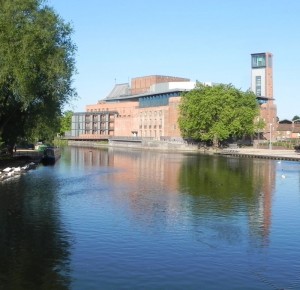The Royal Shakespeare Theatre sits right on the bank of the River Avon in Stratford. When the idea of a permanent memorial to Shakespeare in his town was first suggested in the aftermath of the 1864 Tercentenary Celebrations, it was not obvious that this should be a theatre, or that it should be by the river. But when Charles Edward Flower purchased some land by the river, previously a builders’ yard, the project took off. Flower was able to see the potential for a memorial that would be within sight of the church in which he was buried.
The successful design took advantage of the fact that the building would be seen from all sides, especially from across the river. A mixture of gothic and Tudor, as Marian Pringle explains in her book on the architecture of the theatres, “the pinnacles and turrets of the main building were to earn comparison with a German fairy-tale castle”. On the inside though, the auditorium drew comparisons with a non-conformist chapel. Perhaps this contrast is appropriate for the theatre as it was: a place of dream and imagination, based on discipline and principle.
The theatre opened in 1879, with a grand opening featuring a specially-written overture and brand new painted sets created by the London scenic artist John O’Conor. The theatre might not be on the same scale as Henry Irving’s Lyceum in London but within a few years it had established its own character under the idealistic actor-manager Frank Benson and his wife Constance. Benson was a wonderfully eccentric and inspirational character who created a real company for their actors, many of whom went on to lead successful careers. The Old Bensonians (actors who had worked with his company) remained legendary. Benson himself was reputed to go for swims in the river between appearances on stage, sometimes during the performance.
When the original theatre burned to the ground in March 1926 it was not saved even by the proximity of so much water. George Bernard Shaw, who had hated the building, sent a telegram of congratulation.
Six years later a new building opened. The shell of the old auditorium lay pretty well abandoned, topped with a simple roof and used only for rehearsals. The new theatre seemed brash by comparison. Modernist in design, the architect was a modern young woman, Elisabeth Scott. The building hardly had a curve about it on the outside and it quickly became known as “the jam factory”. The inside, though, was less harsh. A traditionally painted act drop hung in front of the stage, there were beautifully inlaid wooden doors, and there was an elegant spiral staircase.
Within a month of the glamorous royal opening by the Prince of Wales, shown in this Pathe News film clip, the river rose and the theatre flooded. Again, the river had proved no friend to the theatre.
From 1932 until the present day the Memorial Theatre, rechristened the Royal Shakespeare Theatre in 1961, was an almost continuous home for Shakespeare until the beginning of the redevelopment in 2007. A few years before, in 1998, another flood struck. The Tempest was the play being performed as the rain fell and the water rose by 13 feet. In July 2007 there was another flood and a performance of Macbeth, Shakespeare’s unluckiest play, at the Swan Theatre, had to be cancelled.
Now the theatres have been reopened access to the river has been improved so that everyone can enjoy the view across the river and the recreation ground towards Holy Trinity Church and the open countryside beyond. The river makes the Royal Shakespeare Theatre one of the most beautifully-sited of all theatres, and associates it forever with the house dramatist, the Swan of Avon.





A brilliant brief history of the theatre.
My family have like most locals had long connections with the theatre, my mother had vivid memories of the old theatre burning down in 1926 watching the exhausted horses that pulled the fire engines over from Warwick, several members of my family worked there and appeared on the stage as extras. So for many local people it really does feel like it is “ours”.
I think the feeling of ownership you mention is quite common, though there are also local people who want nothing to do with the theatre! It’s such an irony to me that the theatre burned down in broad daylight, next to a large river which it should have been possible to use to control or put out the flames.